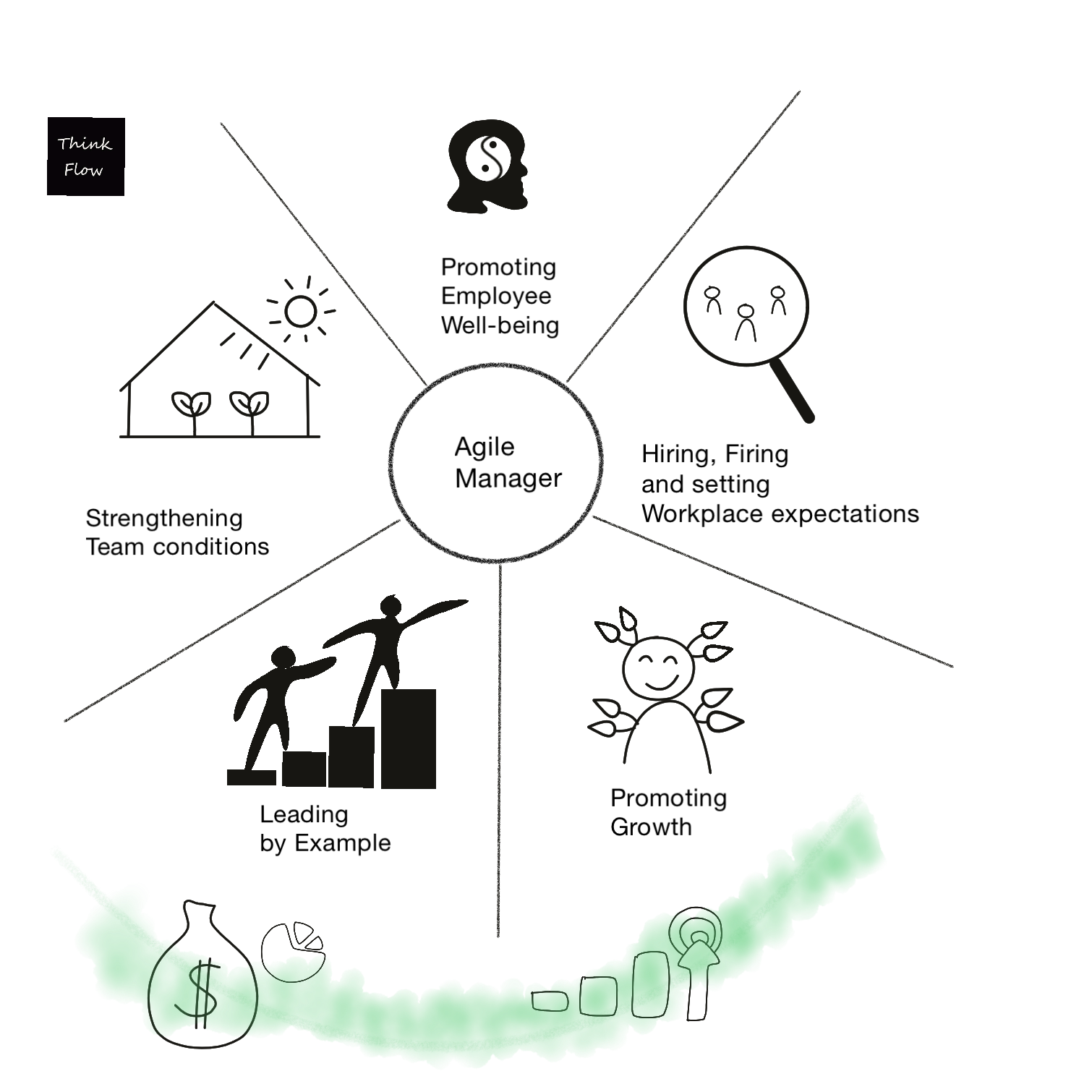This article has been used as main input to the “The role of People Manager in SAFe”.
Introduction
When an organization adopts agile principles and ways of working, the role of the manager also changes.
This article will help you to understand how the role of Manager change and what the responsibilities are.
By Manager, we refer to a role having responsibility for staff working in agile teams and team of teams.
We also refer to Scrum Master, or SM for short, being a role responsible for way of working and progress for a team or team of teams. The third role mentioned is Product Owner (PO) or Product Manager (PM) having product content authority. These roles may have different names in your context.
Transition for a manager
There are a number of things that will remain in the responsibility of the manager, and we will come back to those. Below are a few highlights of what will change, what the manager will move away from and what they will move more towards, or things that they must do more of when adopting an agile way of working in the organization.

Moving from being the expert frequently asked for guidance and approval.
Towards being a servant leader with a coaching mindset asking questions so that team can increase their ability to take ownership.
Instead of directly involving themselves in deliveries they apply a more holistic view and build an organizational environment that facilitates smooth value flow.

Moving from traditional instructive leadership telling staff what to do and how.
Towards providing aligning direction and empowering self-organization towards the established direction. Promoting a collaborative team environment. Instead of directly involving themselves in deliveries they apply a more holistic view and build an organizational environment that facilitates smooth value flow. Supporting teams to work independently and stepping in when asked to remove obstacles.

Moving from being responsible for product content authority, ways of working, ensuring progress or daily activities of direct reports.
Towards taking a step back, delegating content authority to PO/PM, progress and way of working to SM. Instead leveraging their skills in the people perspective.
Since the manager role changes and will focus more on developing people and optimizing the organization for value delivery, some managers may choose to change path. Depending on their individual passion it could be to move towards product content role as PO/PM or way of working role as SM.
Responsibilities for a manager
When performing the transitions outlined in previous section, what responsibilities do you end up with as manager in an agile context? This section will explore that question by elaborating the five primary areas of responsibility, shown in this diagram.

Next, we will dive into each of these areas to help you understand specific activities crucial for effective execution.
Promoting Employee Well-being

- Enhance Health and Work Environment: Care for employees’ physical and mental health and promote appropriate activities enhancing well-being aligned with applicable regulations. Ensure a supportive physical work environment that promotes well-being.
- Support in Crisis Management: Act as a pillar of support during challenging times, providing guidance and assistance to employees facing crises, both personal and professional.
- Manage Stress and Foster Inclusion: Provide strategies and guidance to mitigate stress levels within the team while cultivating an inclusive environment where every member feels valued and respected.
Hiring, Firing, and Setting Workplace Expectations

- Setting Expectations and Salaries: Define clear expectations for performance, conduct, and contribution, aligning them with workplace norms. Additionally, oversee salary and compensation structures in the context of teamwork over individual job descriptions.
- Managing Workplace Norms: Uphold and reinforce workplace norms that support Agile principles and practices, fostering an environment supportive to collaboration and innovation.
Norms are commonly established at the corporate level and may cover various aspects such as ethical behavior and adherence to corporate policies.- Navigating Hiring and Firing: Facilitate the hiring process by identifying and onboarding suitable talent, while also managing the delicate task of personnel changes when necessary.
Promoting Growth

- Competence Development Planning: Facilitate discussion and creation of development plans for teams and their members. Assist in identifying pathways for skill enhancement and growth.
- Active Follow-up and Guidance: Regularly monitor and guide progress for teams and their members according to their development plans, providing necessary resources and support.
- Facilitate Growth Opportunities: Enable growth opportunities that align with both personal aspirations and organizational needs identified in collaboration with e.g., Scrum Masters, Product Owners and similar roles on team of teams’ level.
Leading by Example

- Exemplify New Behaviors: Reflect on how your current behavior aligns with the desired behaviors and attitudes according to agile values. Adjust and act appropriate behavior in a way that works for you and sets an example for others to follow.
- Address Resistance to Change: Proactively address concerns and resistance from individuals or teams in their agile transition. Foster a culture that embraces change and continuous improvement.
- Cultivate a Culture of Adaptability: Encourage adaptability and flexibility within the team, emphasizing the importance of evolving with changing circumstances.
Strengthening Team conditions

- Extend Scrum Master Coaching: Cooperate on equal terms with Scrum Masters (SMs) to identify ways to collaborate. Extend SMs, as needed, in their coaching efforts.
- Empower Product Owners: Cooperate on equal terms with Product owners to identify ways to collaborate. Enable them to embrace full product ownership centered around product value.
- Strengthen other conditions: Identify and assist as necessary to remove any impediment to flow of value. Foster a culture of Psychological safety, Learning and improvement. Assist the team in becoming more self-sufficient.

The five areas above are to be carried out within relevant frames and constraints including available Budget and objectives cascading through the Line organization.
As a manager, navigating these responsibilities contributes significantly to the Agile journey of both the team and the larger organizational ecosystem. Balancing these multifaceted duties requires a blend of leadership, empathy, and a keen understanding of Agile principles, ultimately fostering an environment where teams grow.
Mastering these responsibilities as a manager plays a crucial role in the team’s success within an Agile context fostering innovation and productivity in the organization.
Final words
You need to explore your individual and unique journey
This article has explored how the role of manager change in a lean-agile context and what the responsibilities are. In a second article coming soon, we will share some common challenges managers may face on their journey transitioning into the new context. For those looking for hands-on advice and tips on how to contribute as managers to agile team events, that will also be shared in that article.
You as a manager need to find your foothold in the transition depending on your context. This article has outlined the transition and the role in generic terms, and you need to explore your individual and unique journey. A powerful approach is to join forces with other managers within your organization to network, exchange perspectives and support each other.
We at Think Flow can also support in workshops or discussions, don’t hesitate to get in contact if you like.
To be sure you dont miss any of our coming articles or news updates you can sign up for our newsletter that we will send out once per quarter. Follow the link below and go to the bottom of that page and register your email.
https://thinkflow.se/
This work is licensed under CC BY-NC 4.0
Authors

Mikael Broomé


